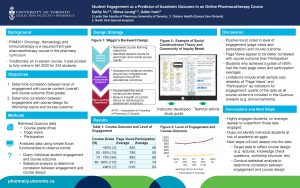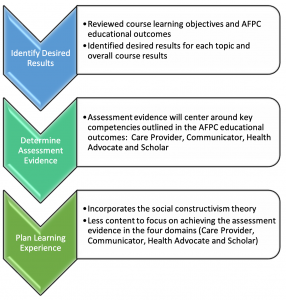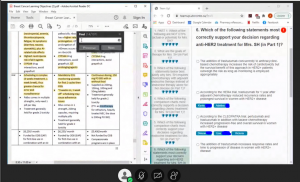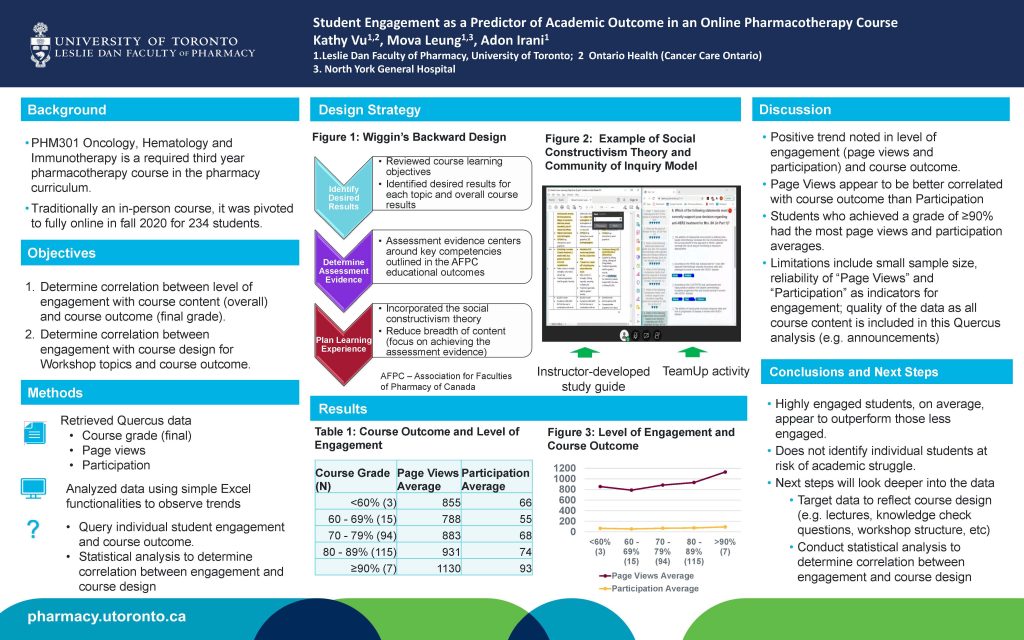Kathy Vu
Course/ProgramPHM653 – Contemporary Topics in Oncology |
 Poster and Video Presentation – Teaching and Learning Symposium, May 2021 Poster and Video Presentation – Teaching and Learning Symposium, May 2021 |
Design Context
This course is a required third year pharmacotherapy course in the pharmacy curriculum. Due to the COVID-19 pandemic, this course was taught online in fall 2020 to 234 students. This online course used asynchronous and synchronous lectures, tutorials and workshops held weekly or biweekly. There is an asynchronous online discussion board (PeppeR) to encourage communication and community (important as students were adapting to online learning). Gamification (TeamUp!) was used as a pedagogical approach to promote group work, enjoyment, engagement and competition. Workshops are structured using a scaffolding approach – lectures, study guides, mini quizzes were used to instill knowledge; pre-workshop tutorials and workshops were used to apply the knowledge; and case-based assignments and open-book examinations were used to assess knowledge.
Instructional Challenge
The main instructional challenge is engaging students in a complex topic (oncology) that is both challenging and dense in content. It is difficult to pick out the students who are struggling and to understand if the course design is optimal for online learning.
Quercus provides instructors with basic analytical tools to get a snapshot of course activity (i.e. page views) over time and performance (i.e. grades). However, this cohort approach to viewing engagement does not let instructors see the students who may be struggling with the content or instructional design as they are “hidden” behind a virtual wall.
Design Strategy
As an extension of the social constructivism theory, the community of inquiry framework was used to ensure that social presence, teaching presence, learner presence and cognitive presence are all considered to facilitate successful educational experiences in online distance learning environment (Garrison, Anderson and Archer, 1999). This formed the basis of the workshop design. Workshops used TeamUp! as the social environment where small groups gathered to answer questions based on a patient case. Students referred to study guides, published literature and existing knowledge to construct new knowledge as a group. A deliberate scaffolding approach was taken in the course design to ensure students could succeed. Lectures with knowledge check questions and instructor-created study guides formed the basis for delivering information. Pre-workshop tutorials and an online discussion board (PeppeR) were used to reinforce learning by providing an opportunity for students to ask clarifying questions to engage with the content. Cases-based assignments were used to apply knowledge and workshops were used to analyze and evaluate knowledge.
Use of Data to Inform Design Iteration and Instruction
Using data science, we are pulling information about students’ access to course materials to determine/correlate engagement with learning outcomes. We are making the following assumptions: accessing course content by clicking on links and documents etc. constitutes engagement. We will not look at the number of clicks or time spent on each activity. We will then perform statistical analysis (univariate and multivariate analysis) to better understand the correlation between the level of engagement and outcome. We will also aim to better understand if the design of larger, more complex workshop topics is successful in learning outcomes if the level of engagement is high.
Objective #1
Determine if there is any correlation between level of engagement with course content (overall) and course outcome (grade).
Objective #2
Determine if there is a correlation between engagement with course design for Workshop topics and course outcome (grade).
Next Steps
An initial review of available reports from Quercus showed a positive trend in Page Views and Participation and final grades. We can see that students who performed the best (>90%), on average, had the most Page Views and Participation scores. However, these measures are limited by what is included in the Page Views and Participation definition.
I am working with colleagues to pull course utilization information. Using data science, we are hoping to extract meaningful results from Quercus. We are currently validating the data (quality assurance) and finalizing the results in order to perform statistical analysis.
Poster
Presented at the Teaching and Learning Symposium, May 2021.
Click to download poster PDF in a new tab



